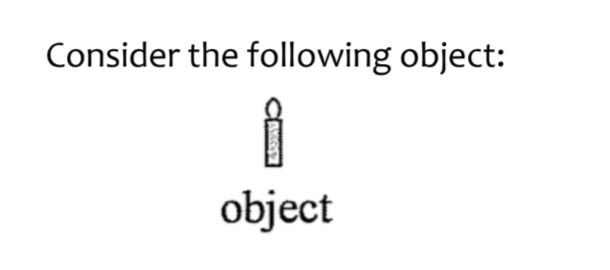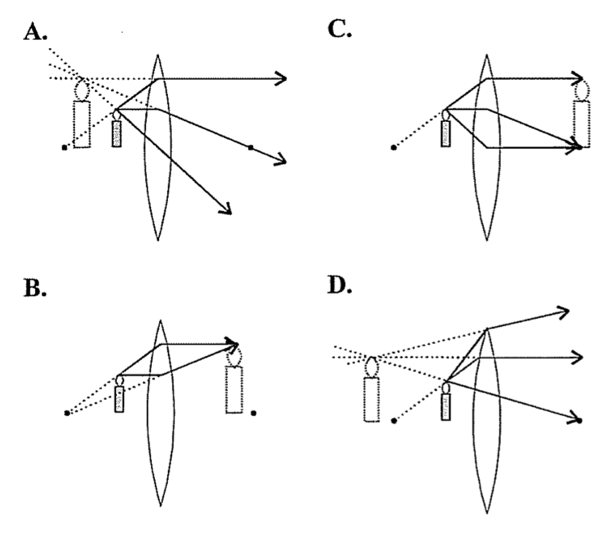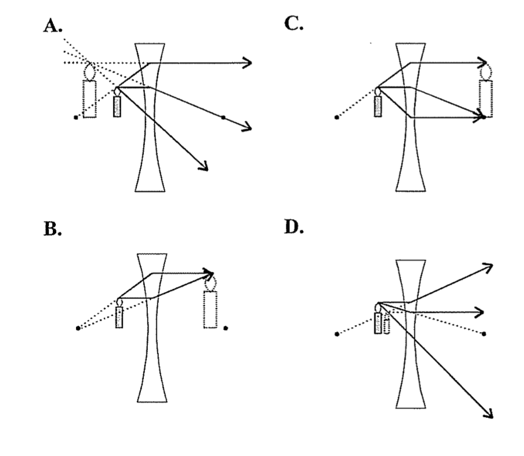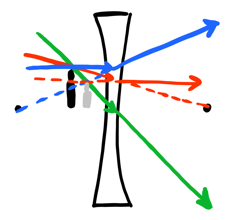.png?width=1080&name=Statistical%20Mediation%20%26%20Moderation%20in%20Psychological%20Research%20(9).png) Ray diagrams can look intimidating, but they don’t have to be! In this blog post, we will tackle five examples of ray diagrams.
Ray diagrams can look intimidating, but they don’t have to be! In this blog post, we will tackle five examples of ray diagrams.

In the following problems, we want to figure out which ray diagram represents the object and its image. To do this, we need to trace several rays from the object and determine how they reflect or refract.
Problem 1: choose the correct ray diagram

In this problem, we are dealing with a convex lens. Let’s draw three rays, all originating from the top of the object.
First, we draw a ray through the focal point on the same side as the object. This ray will refract parallel to the ground. Next, we draw a ray parallel to the object. This ray will refract through the focal point on the opposite side of the lens. Finally, we draw a ray through the center of the lens. This ray will not refract. In other words, it will continue to travel along its original trajectory.

Now let’s combine these three rays and trace their paths to a point of intersection. The point of intersection demarcates the top of the image. The correct answer is A.

As you may recall, an object within the focal distance of a converging lens will form an upright, virtual image on the same side of the lens as the object. Now you can draw ray diagrams to illustrate this point to yourself!
Problem 2: choose the correct ray diagram

Here we have another convex lens, but this time our object is outside of the lens’ focal point. Again, let’s draw three rays, each emanating from the top of the object.
First, we draw a ray through the focal point on the same side as the object. This ray will refract parallel to the ground. Next, we draw a ray that is parallel to the ground. This ray will refract through the focal point on the opposite side of the lens. Finally, we draw a ray through the center of the lens. As with the previous problem, this ray will continue to travel along its original trajectory.

Now let’s combine these three rays and trace their paths to a point of intersection, and find that the correct answer is D. The takeaway here is that an object outside of the focal length of a lens will form an inverted, real image on the opposite side of the lens.

Problem 3: choose the correct ray diagram

Now we have a concave lens, which diverges light to create a virtual image on the object side of the lens.
First, we draw a dotted line from the tip of the object to the focal point on the opposite side. Then we draw a ray traveling in the direction of the dotted line. This ray will refract parallel to the ground. Next, we draw a ray parallel to the ground. Then we draw a dotted line from the left focal point to the lens. The ray will will refract along this line. Finally, we draw a ray through the center of the lens. As with the previous problem, this ray will continue to travel along its original trajectory.

Now let’s combine these three rays and trace their paths to a point of intersection, and find that the correct answer is D. The takeaway here is that a concave lens will produce an upright, virtual image on the object side of the lens.

Problem 4: choose the correct ray diagram

Now we have a concave mirror, which can either create a virtual upright image or a real inverted image depending on the location of the object. In this problem, the object is within the focal distance, so the mirror will produce an upright virtual image on the opposite side of the mirror.
Recall that for lenses, we need to draw three rays. For mirrors, however, we only need to draw two.
First, we draw a dotted line from the left focal point to the mirror. Along this trajectory, we draw a ray from the object to the mirror. This ray will reflect parallel to the ground. Next, we draw a ray parallel to the ground. This ray will reflect through the left focal point. Finally, we trace the rays to a point of intersection and see that the answer is B, a virtual upright image on the opposite side of the mirror.

The takeaway point here is that a concave mirror will produce a virtual upright image when the object is within the focal distance of the mirror.
Problem 5: choose the correct ray diagram

Our final problem deals with a convex mirror. Convex mirrors diverge light, and they produce virtual upright images on the opposite side of the mirror.
As with the previous mirror problem, we only need to draw two rays here. First, we draw a dotted line from the tip of the object to the focal point on the opposite side of the mirror. Along this trajectory, we draw a ray from the tip of the object to the mirror. This ray will reflect parallel to the ground.
Next, we draw a ray parallel to the ground. From the point where the ray hits the mirror, we draw a dotted line to the focal point on the other side of the mirror. The ray will reflect along the trajectory of this dotted line.
Finally, we trace the rays to a point of intersection and see that the answer is B, a virtual upright image on the other side of the mirror.

The takeaway point here is that a convex mirror always creates a virtual upright image on the opposite side of the mirror.
Comments